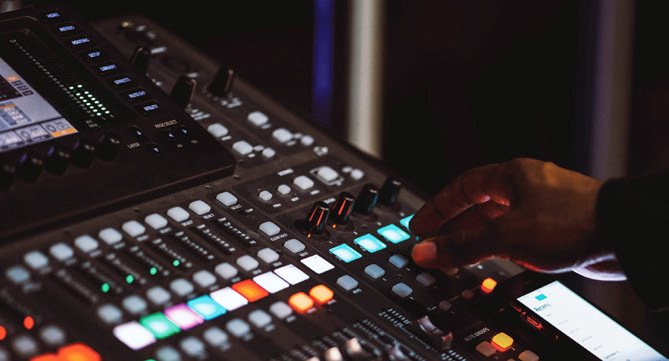
When a signal is consistently compressed in the range of -6 dB to -12 dB, and similar makeup gain is added, a new issue is introduced. When the source is no longer present to induce compression, that instrument or vocal will be elevated in level +6 dB to +12 dB, which can cause feedback, ambient bleed, and other unwanted issues.
In the same way, if the multiband compressor is being used to tame high-mid frequencies in a vocal that are harsh or shrill, you almost always have to turn that vocal up manually when the singer is singing in a range that lacks high mids, so it’s a cat and mouse game that is hard to win. With a lot of tweaking, they can be fantastic, dynamic tools, but there are always pros and cons to using this plugin.
Checks and balances: Use the “Insert IN/Insert OUT” rule. When you’ve got the plugin settings where you like them, try hitting the bypass button on the plugin screen or the Insert OUT button on the console. If the gain jumps or dips dramatically, you’ve still got work to do. If the lead vocal sounds lifeless and lacks power with the plugin IN, but powerful and clear when you bypass it, keep working at it. You’re not there yet.
The same goes for tonality. Overuse of a multiband compressor can often leave an input sounding dull or thin. Try bypassing the plugin and then manually adjust the fader and EQ instead of having the multiband compressor do all the work.
Plugin and bus latency. More and more digital consoles are incorporating “delay compensation” in their signal flow architecture to deal with ever-increasing busing and plugin use.

But some consoles don’t use this process of ensuring all of the signal paths line up when they reach the final Master Left-Right (L-R) bus. If you’ve ever double-bused drums (sending those inputs to the Main L-R while also sending them to a drum group – which is also routed to the Main L-R), you may have experienced signal degradation caused by latency of the “longer” path.
Sonically, it appears as low or low-mid frequency cancellations or the appearance of a doubling or “flam” effect. The extra time it takes for the signal to travel through the group to the Main L-R is longer than if it goes directly to the Main L-R, so latency causes phase issues, and the result is very unpleasant.
Using a plugin on one input can seem harmless – until you combine it with a separate input that has a similar sonic signature. Here’s a painful, personal example: I was trying out the Waves “Smack Attack” plugin on live kick and snare drums. It’s a transient shaper that gives the user control over the attack and decay of the input. Very cool and one of my favorites.
I started with the kick drum and it was sounding great, and was feeling pretty good about things until the playback tracks kicked in (including a big round kick track) and suddenly, the punch and low-end content in the mix disappeared and became very sloppy. It took me a minute to figure it out.
The problem was that the live kick was being “slowed down” in time because of the plugin, but the powerful sounding kick on the track was not. I added some input delay to the kick track from playback and it all came back together.
I was able to fix this because I knew the low-end and sub on the live kick was fine and summed nicely with the kick track without the plugin engaged, but it fell apart when I added the plugin. Often, these things are added and never checked with other similar inputs, so latency issues can go unnoticed.
Checks and balances: To see if your digital console is providing delay compensation, perform the following test. Assign the kick and snare to the Main L-R only and give it a listen. Then, assign them to a group and assign that group to the Main L-R. Does the low-frequency content decrease, and do the drums sound “sloppy” or slightly out of time? If the answer is yes, then you most likely don’t have a delay compensation feature on the console – or – it might be hiding in a menu somewhere.
Another way to avoid latency issues is to ensure you have equal path lengths. I sometimes employ parallel bus compression on drums and other instrument groups. If your console doesn’t automatically compensate, here’s one way to set this up: route the drums to two stereo groups. These groups are assigned to the Main L-R, but the inputs themselves are not.
Next, put the same compressor on both groups. One compressor is set to never compress at all, and the other is set to compress a fair bit. Putting the same compressor on both groups ensures the signal paths are identical in length, and latency issues will almost always be avoided.
